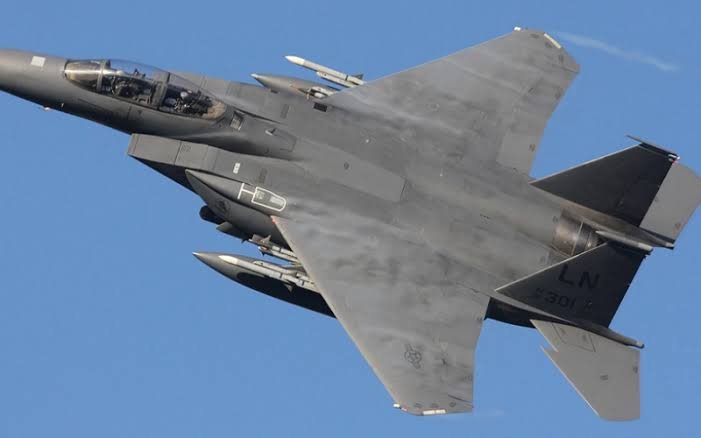China’s 6G-Powered Electronic Warfare System: A Game-Changer in Modern Air Combat
In a remarkable technological breakthrough that could reshape the future of air combat, Chinese scientists have reportedly developed an advanced electronic warfare (EW) system powered by 6G technology, capable of jamming the radar of U.S. F-35 stealth fighter jets within seconds. The project, which has already attracted global attention, highlights China’s rapid strides in integrating next-generation technologies into its defense sector.
China’s 6G-Powered Electronic Warfare System: A Game-Changer in Air Combat
In a breakthrough that could redefine aerial warfare, Chinese scientists have developed a revolutionary 6G-powered electronic warfare (EW) system. This new technology is reportedly capable of jamming the radar of advanced stealth fighters, such as the U.S. F‑35, within seconds. The innovation highlights China’s growing dominance in military research and its ability to integrate next-generation communications technology into the heart of its defense strategy.
The Team Behind the Innovation
The project is led by Professor Deng Lei and his team at Huazhong University of Science and Technology (HUST), one of China’s top institutions for engineering and defense research. Their goal was ambitious: to create an EW system that can outpace, outsmart, and outperform existing jamming technologies, providing a strategic edge in contested airspace.
How the 6G EW System Works
Stealth aircraft like the F‑35 Lightning II are designed to operate under the radar, relying on advanced sensors and radar-absorbent designs. However, these stealth jets still require radar and sensor data for navigation, targeting, and communications.
The new Chinese EW system operates by intercepting and jamming these radar and sensor signals. By doing so, it effectively “blinds” enemy aircraft for critical moments, making them vulnerable and disrupting their mission. Even a short window of jamming can be enough to change the outcome of an aerial engagement.
What sets this system apart is its use of 6G technology, which offers:
-
Higher Speeds: Enables extremely rapid signal processing.
-
Greater Bandwidth: Supports complex jamming across multiple frequencies.
-
Real‑Time Adaptation: Quickly adjusts jamming methods based on enemy countermeasures.
These advances make the system ideal for high-stakes aerial combat scenarios, where split-second decisions can mean victory or defeat.
Why 6G Is a Game-Changer
Modern air combat is a race for speed and precision. The side that can respond the fastest to threats and manipulate the electromagnetic spectrum wins.
6G’s ultra‑high frequency, massive data capacity, and low latency give this EW platform a unique edge:
-
Enables jamming of multiple targets simultaneously.
-
Adjusts frequencies on the fly to counter enemy defenses.
-
Operates reliably over longer ranges compared to older technologies.
This is a huge improvement over traditional 4G- and 5G-based EW systems, making it much harder for opposing forces to defend themselves.
Impact on Stealth Aircraft like the F‑35
The F‑35, a cornerstone of U.S. airpower, was designed for stealth. But its low radar signature can be neutralized if its sensors and communications are disrupted. The new Chinese EW system threatens precisely this vulnerability.
If deployed effectively, the 6G EW system could:
-
Force F‑35 pilots to switch to visual targeting, limiting their range and precision.
-
Disrupt critical links between aircraft and command centers.
-
Degrade the effectiveness of precision‑guided weapons.
This could shift the balance of airpower in hotspots like the South China Sea, the Taiwan Strait, and the East China Sea, where tensions already run high.
A New Chapter in the Global EW Arms Race
China’s breakthrough is part of a global trend where nations are racing to dominate the electromagnetic spectrum. The United States, Russia, Israel, and many European nations have invested billions in next‑gen EW capabilities, making it one of the most contested domains in modern warfare.
Today, victory is not just about who has the best planes or weapons — it’s about who can outmaneuver the enemy by controlling the flow of information.
Early Development, Massive Potential
Although still in its experimental phase, the 6G EW platform is positioned to evolve quickly. In the years to come, researchers expect to:
-
Reduce the system’s size and power requirements for deployment on smaller platforms.
-
Enhance its resistance to counter‑jamming efforts.
-
Integrate artificial intelligence for fully autonomous jamming capabilities.
These advances could make future EW platforms highly mobile and adaptable across a range of combat scenarios.
Implications for Global Security
China’s leap forward in EW technology raises critical questions for policymakers, military planners, and analysts:
-
Will the U.S. and its allies intensify efforts to upgrade their own stealth platforms?
-
Will this spark a new global EW arms race?
-
How will this affect the balance of military power in contested regions like the Taiwan Strait and the South China Sea?
China’s advances in EW are a central piece of its long‑term military modernization strategy, aligning with its focus on artificial intelligence, quantum computing, and hypersonic weapons.
The Role of Civil‑Military Collaboration
This project showcases the effectiveness of civil‑military collaboration in China. Leading universities, state research labs, and military institutions work hand‑in‑hand, ensuring that breakthroughs in civilian technology quickly benefit defense applications.
The Future of Aerial Warfare
The emergence of 6G‑powered EW platforms signals a shift in aerial combat: future conflicts will be won not just by faster jets or stronger missiles, but by those who can best manipulate the electromagnetic spectrum. The ability to jam, spoof, or hijack enemy sensors and communications will be the deciding factor in many engagements.
Conclusion
China’s 6G‑powered EW breakthrough marks a significant milestone in military technology. By potentially neutralizing stealth fighters like the F‑35, it reshapes the dynamics of airpower and signals a new era of warfare. As nations race to harness the power of 6G, victory will belong to those who can dominate the electromagnetic battlefield and operate at the speed of light.
The Team Behind the Innovation
This cutting-edge project is led by Professor Deng Lei and his research team at Huazhong University of Science and Technology (HUST), one of China’s premier institutions for advanced engineering and technology research. Professor Deng and his colleagues have focused their work on combining breakthroughs in 6G wireless communication with the demands of modern electronic warfare.
Their goal: to create a system that can outpace, outsmart, and outperform existing EW tools, giving China a strategic edge in any potential conflict involving air power.
Heavy Rainfall and Hail Storms Expected in these Cites of Pakistan
Read This Article
How the System Works
At the core of this new system is its ability to disrupt radar signals that are critical to the operation of stealth aircraft like the F-35 Lightning II. While stealth aircraft are designed to avoid detection by conventional radar, they still rely on radar and sensors for navigation, targeting, and situational awareness.
China’s 6G electronic warfare platform works by intercepting and jamming these radar signals, creating confusion and effectively “blinding” enemy aircraft for a crucial window of time. In high-stakes combat, even a few seconds of lost radar capability could spell the difference between victory and defeat.
What sets this system apart is its use of 6G technology. Unlike earlier generations, 6G offers faster data processing, greater bandwidth, and more sophisticated signal manipulation. This enables the EW system to:
-
Jam enemy radar signals with greater speed and precision
-
Adapt to changing signal patterns in real time
-
Evade countermeasures that would neutralize older jamming systems
Why 6G Is a Game-Changer
Electronic warfare is often a battle of speed and complexity. The side that can process data faster, respond to threats more efficiently, and outmaneuver enemy systems gains a decisive advantage.
6G’s ultra-high frequency, massive data capacity, and ultra-low latency make it ideally suited for such tasks. By leveraging these characteristics, China’s new EW system can:
-
Target multiple enemy aircraft or systems at once
-
Change jamming frequencies dynamically to avoid detection
-
Operate over longer distances without losing effectiveness
This represents a major leap over 4G- and 5G-based systems, which while effective, are increasingly vulnerable to counter-EW measures.
Impact on Stealth Aircraft Like the F-35
The F-35 stealth fighter jet is often touted as one of the most advanced military aircraft in the world. Its low radar cross-section allows it to operate in hostile environments with minimal risk of detection.
However, experts have long warned that stealth is not invincible. Radar jamming, signal spoofing, and other electronic warfare techniques can still compromise a stealth jet’s ability to function as designed.
China’s new system could turn one of the U.S. military’s key advantages into a potential vulnerability. If deployed effectively, such a jammer could:
-
Force F-35 pilots to rely on visual targeting, putting them at a disadvantage
-
Disrupt communications between aircraft and command centers
-
Prevent accurate use of precision-guided weapons
This could dramatically alter the balance of power in regions like the South China Sea, Taiwan Strait, and East China Sea, where both U.S. and Chinese forces operate.
The Global Arms Race in Electronic Warfare
China’s development of this 6G-powered EW platform underscores a larger trend: the growing importance of electronic warfare in modern military strategy. Across the world, nations are investing billions in technologies that can dominate the electromagnetic spectrum.
The U.S., Russia, Israel, and European powers have all developed sophisticated EW systems. But China’s move into 6G-enabled jamming could put it ahead in this increasingly critical domain.
Military analysts note that the future of warfare will likely be determined less by who has the most tanks or planes, and more by who controls the flow of information on the battlefield.
Early Stages, But Huge Potential
While reports indicate that China’s 6G EW system is still in the experimental phase, the scientific community is optimistic about its future. As 6G technology matures—expected to be fully realized by the 2030s—the capabilities of this jammer and related systems could grow exponentially.
Researchers hope to:
-
Reduce the size and power consumption of the jamming units
-
Improve resistance to counter-jamming efforts
-
Integrate artificial intelligence to make the system more autonomous
These advancements could make electronic warfare tools not just powerful, but also highly mobile and adaptable to different combat scenarios.
Implications for Global Security
This technological leap raises several important questions for policymakers, military planners, and security analysts worldwide:
-
How will the U.S. and its allies respond? The Pentagon will likely accelerate efforts to harden F-35 systems and develop counter-EW measures.
-
What happens to the balance of power in Asia? China’s growing capabilities could embolden its posture in disputed regions.
-
Will this trigger an electronic warfare arms race? Other nations may rush to develop similar or better systems, leading to further militarization of the electromagnetic spectrum.
China’s Broader Strategy
China’s investment in 6G electronic warfare aligns with its broader military modernization goals. The country’s leadership has made no secret of its desire to build a world-class military by mid-century, capable of competing with or surpassing U.S. forces in key areas.
By focusing on next-generation technologies—artificial intelligence, quantum computing, hypersonic weapons, and now 6G EW systems—China hopes to leapfrog older military models and build an edge in future conflicts.
The Role of Universities and Civil-Military Collaboration
Huazhong University of Science and Technology is just one example of how China’s civil and military sectors collaborate closely on research and development. Universities, tech firms, and state labs work together under government direction to achieve strategic technological goals.
This model enables rapid progress and ensures that innovations like 6G communications benefit both civilian and defense applications.
China’s 6G-Powered Electronic Warfare System: A Game-Changer in Air Combat
In a breakthrough that could redefine aerial warfare, Chinese scientists have developed a revolutionary 6G-powered electronic warfare (EW) system. This new technology is reportedly capable of jamming the radar of advanced stealth fighters, such as the U.S. F‑35, within seconds. The innovation highlights China’s growing dominance in military research and its ability to integrate next-generation communications technology into the heart of its defense strategy.
The Team Behind the Innovation
The project is led by Professor Deng Lei and his team at Huazhong University of Science and Technology (HUST), one of China’s top institutions for engineering and defense research. Their goal was ambitious: to create an EW system that can outpace, outsmart, and outperform existing jamming technologies, providing a strategic edge in contested airspace.
How the 6G EW System Works
Stealth aircraft like the F‑35 Lightning II are designed to operate under the radar, relying on advanced sensors and radar-absorbent designs. However, these stealth jets still require radar and sensor data for navigation, targeting, and communications.
The new Chinese EW system operates by intercepting and jamming these radar and sensor signals. By doing so, it effectively “blinds” enemy aircraft for critical moments, making them vulnerable and disrupting their mission. Even a short window of jamming can be enough to change the outcome of an aerial engagement.
What sets this system apart is its use of 6G technology, which offers:
-
Higher Speeds: Enables extremely rapid signal processing.
-
Greater Bandwidth: Supports complex jamming across multiple frequencies.
-
Real‑Time Adaptation: Quickly adjusts jamming methods based on enemy countermeasures.
These advances make the system ideal for high-stakes aerial combat scenarios, where split-second decisions can mean victory or defeat.
Why 6G Is a Game-Changer
Modern air combat is a race for speed and precision. The side that can respond the fastest to threats and manipulate the electromagnetic spectrum wins.
6G’s ultra‑high frequency, massive data capacity, and low latency give this EW platform a unique edge:
-
Enables jamming of multiple targets simultaneously.
-
Adjusts frequencies on the fly to counter enemy defenses.
-
Operates reliably over longer ranges compared to older technologies.
This is a huge improvement over traditional 4G- and 5G-based EW systems, making it much harder for opposing forces to defend themselves.
Impact on Stealth Aircraft like the F‑35
The F‑35, a cornerstone of U.S. airpower, was designed for stealth. But its low radar signature can be neutralized if its sensors and communications are disrupted. The new Chinese EW system threatens precisely this vulnerability.
If deployed effectively, the 6G EW system could:
-
Force F‑35 pilots to switch to visual targeting, limiting their range and precision.
-
Disrupt critical links between aircraft and command centers.
-
Degrade the effectiveness of precision‑guided weapons.
This could shift the balance of airpower in hotspots like the South China Sea, the Taiwan Strait, and the East China Sea, where tensions already run high.
A New Chapter in the Global EW Arms Race
China’s breakthrough is part of a global trend where nations are racing to dominate the electromagnetic spectrum. The United States, Russia, Israel, and many European nations have invested billions in next‑gen EW capabilities, making it one of the most contested domains in modern warfare.
Today, victory is not just about who has the best planes or weapons — it’s about who can outmaneuver the enemy by controlling the flow of information.
Early Development, Massive Potential
Although still in its experimental phase, the 6G EW platform is positioned to evolve quickly. In the years to come, researchers expect to:
-
Reduce the system’s size and power requirements for deployment on smaller platforms.
-
Enhance its resistance to counter‑jamming efforts.
-
Integrate artificial intelligence for fully autonomous jamming capabilities.
These advances could make future EW platforms highly mobile and adaptable across a range of combat scenarios.
Implications for Global Security
China’s leap forward in EW technology raises critical questions for policymakers, military planners, and analysts:
-
Will the U.S. and its allies intensify efforts to upgrade their own stealth platforms?
-
Will this spark a new global EW arms race?
-
How will this affect the balance of military power in contested regions like the Taiwan Strait and the South China Sea?
China’s advances in EW are a central piece of its long‑term military modernization strategy, aligning with its focus on artificial intelligence, quantum computing, and hypersonic weapons.
The Role of Civil‑Military Collaboration
This project showcases the effectiveness of civil‑military collaboration in China. Leading universities, state research labs, and military institutions work hand‑in‑hand, ensuring that breakthroughs in civilian technology quickly benefit defense applications.
The Future of Aerial Warfare
The emergence of 6G‑powered EW platforms signals a shift in aerial combat: future conflicts will be won not just by faster jets or stronger missiles, but by those who can best manipulate the electromagnetic spectrum. The ability to jam, spoof, or hijack enemy sensors and communications will be the deciding factor in many engagements.
Conclusion
China’s 6G‑powered EW breakthrough marks a significant milestone in military technology. By potentially neutralizing stealth fighters like the F‑35, it reshapes the dynamics of airpower and signals a new era of warfare. As nations race to harness the power of 6G, victory will belong to those who can dominate the electromagnetic battlefield and operate at the speed of light.
The Future of Air Combat
Looking ahead, air combat will likely become a contest not of who has the best aircraft, but of who can best manage and manipulate electronic signals. The side that can jam, spoof, or hijack an enemy’s systems will have a decisive edge Jamming/
China’s 6G jammer is a sign of things to come: battles fought at the speed of light, where data and signals are the primary weapons Jamming.
Conclusion
China’s reported creation of a 6G-powered electronic warfare system capable of jamming the radar of stealth aircraft like the U.S. F-35 represents a significant step forward in military technology. While still in early development, this system could reshape air combat, alter regional security dynamics, and trigger new waves of innovation and competition in electronic warfare Jamming.
The rapid evolution of such technologies underscores how future conflicts may depend as much on electronic tools as on traditional weapons. As nations race to control the electromagnetic spectrum, the next battlefield will likely be one of signals, data, and speed.




